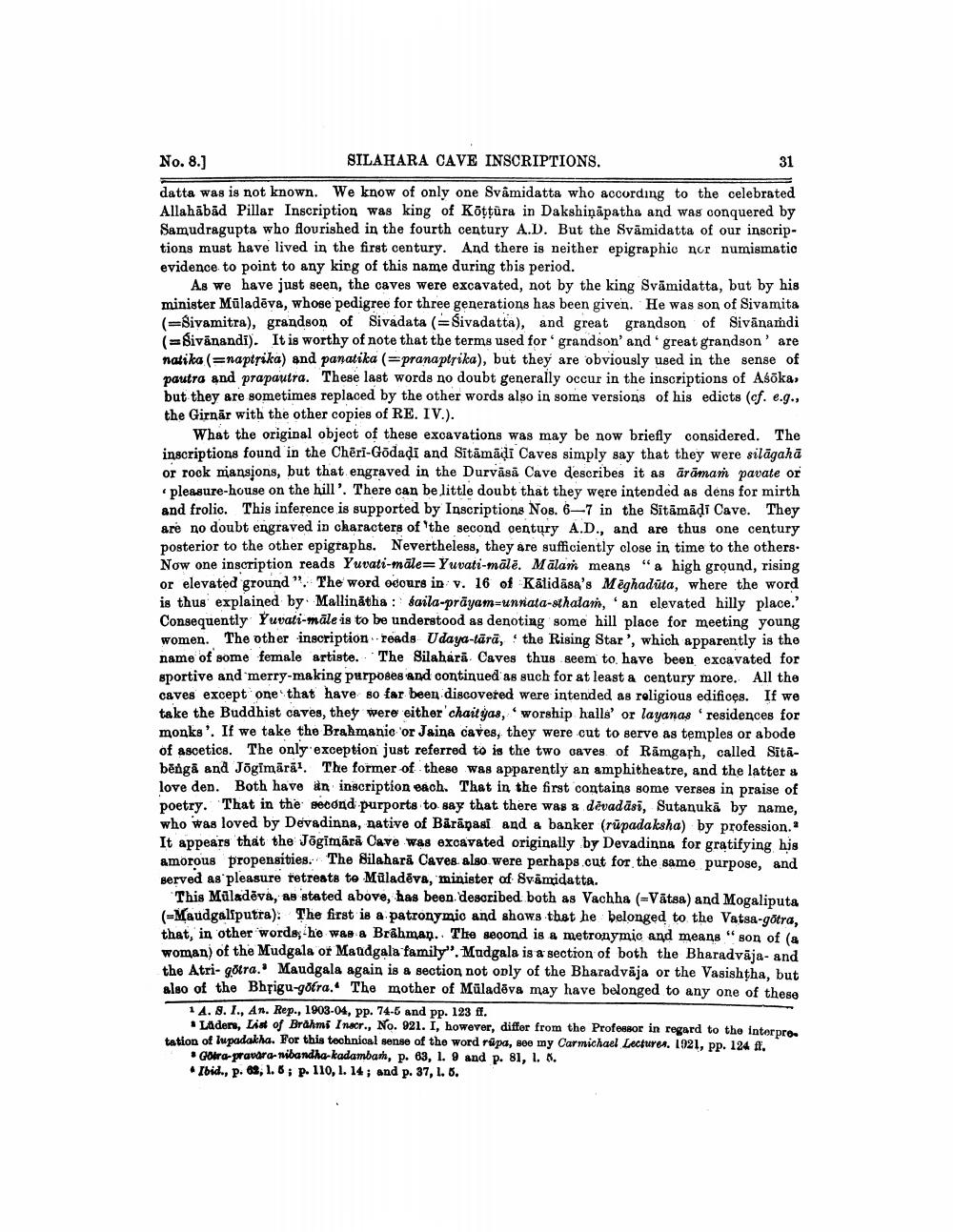________________
No. 8.)
SILAHARA CAVE INSCRIPTIONS. datta was is not known. We know of only one Svâmidatta who according to the celebrated Allahābād Pillar Inscription was king of Köttura in Dakshiņāpatha and was conquered by Samudragupta who flourished in the fourth century A.D. But the Svāmidatta of our inscriptions must have lived in the first century. And there is neither epigraphio ncr numismatic evidence to point to any king of this name during this period.
As we have just seen, the caves were excavated, not by the king Svāmidatta, but by his minister Müladēva, whose pedigree for three generations has been given. He was son of Sivamita (=Bivamitra), grandson of Sivadata (=sivadatta), and great grandson of Sivānamdi ( = Sivånandi). It is worthy of note that the terms used for grandson' and 'great grandson' are natika (=naptrika) and panatika (=pranaptrika), but they are obviously used in the sense of pautra and prapautra. These last words no doubt generally occur in the inscriptions of Asoka, but they are sometimes replaced by the other words also in some versions of his edicts (cf. e.g., the Girnar with the other copies of RE. IV.).
What the original object of these excavations was may be now briefly considered. The inscriptions found in the Chēri-Godadi and Sītāmādi Caves simply say that they were silāgahā or rock mansions, but that engraved in the Durvāsā Cave describes it as ārāmam pavate or « pleasure-house on the hill'. There can be little doubt that they were intended as dens for mirth and frolio. This inference is supported by Inscriptions Nos. 6-7 in the Sitāmādi Cave. They are no doubt engraved in characters of the second century A.D., and are thus one century posterior to the other epigraphs. Nevertheless, they are sufficiently close in time to the others. Now one inscription reads Yuvati-mäle=Yuvati-mālē. Mälan means "a high ground, rising or elevated ground. The word odours in v. 16 of Kalidasa's Meghadüta, where the word is thus explained by Mallinātha : faila-prāyam=unnata-sthalam, an elevated hilly place.' Consequently Yuvati-māle is to be understood as denoting some hill place for meeting young women. The other inscription reads Udaya-lära, the Rising Star', which apparently is the name of some female artiste. The Silahára. Caves thus seem to have been excavated for sportive and merry-making purposes and continued as such for at least a century more. All the caves except one that have so far been discovered were intended as religious edifices. If we take the Buddhist caves, they were either chait yas, worship halls' or layanas residences for monks'. If we take the Brahmanic or Jaina caves, they were cut to serve as temples or abode of ascetics. The only exception just referred to is the two caves of Ramgash, called Sitabēnga and Jögimārā'. The former of these was apparently an amphitheatre, and the latter & love den. Both have an inscription each. That in the first contains some verses in praise of poetry. That in the second purports to say that there was a dévadāsi, Sutanukā by name, who was loved by Devadinna, native of Bärāṇasi and a banker (rūpadaksha) by profession." It appears that the Jõgimārā Cave was excavated originally by Devadinna for gratifying his amorous propensities. The Silahară Caves also were perhaps.cut for the same purpose, and served as pleasure retreats te Müladēva, minister of Svämidatta.
This Maladēva, as stated above, has been described both as Vachha (=Vätsa) and Mogaliputa (Maudgalfputra). The first is a patronymic and shows that he belonged to the Vatsa-gðtra, that, in other words, he was a Brahman. The second is a metronymic and means " son of (& woman) of the Mudgala or Maudgala family. Madgala is a section of both the Bharadvāja- and the Atri- götra. Maudgala again is a section not only of the Bharadvāja or the Vasishtha, but also of the Bhrigu-gofra.. The mother of Müladēva may have belonged to any one of these
14. 8. 1., An. Rep., 1903-04, pp. 74-5 and pp. 123 ff.
• Lader, List of Brahms Incr., No. 921. I, however, differ from the Professor in regard to the Interpro. tation of lupadakha. For this technical sense of the word rupa, see my Carmichael Lecturer. 1921, pp. 124 fl.
. GOtra-pravara-ibandha-kadambach, p. 63, 1. 9 and p. 81, L. 8. • Ibid., p. 62, 1.6; p. 110, 1. 14; and p. 37, 1. 8.




